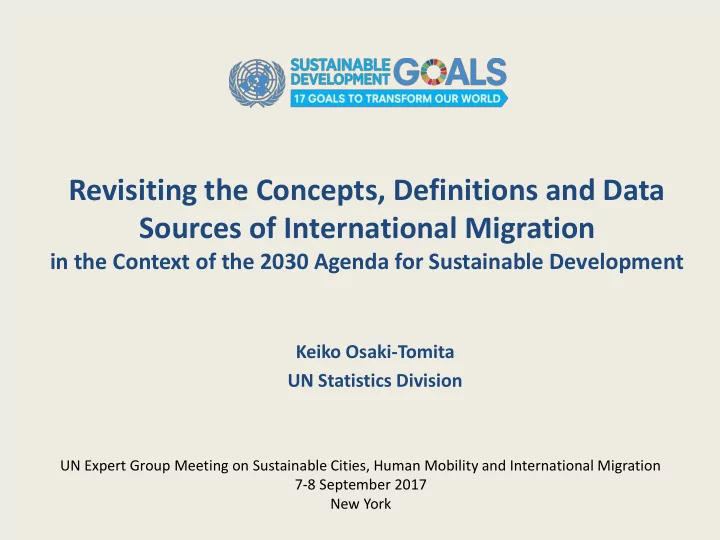

Revisiting the Concepts, Definitions and Data Sources of International Migration in the Context of the 2030 Agenda for Sustainable Development Keiko Osaki-Tomita UN Statistics Division UN Expert Group Meeting on Sustainable Cities, Human Mobility and International Migration 7-8 September 2017 New York
Outline • Statistical challenges posed by recent global policy initiatives – The 2030 Agenda for Sustainable Development – Mew York Declaration for Refugees and Migrants • Where the conceptual refinements on international migration are needed? • How can we leverage the sources of migration statistics?
Long Journey to Standerdize Migration Statistics • The efforts by the international community to improve statistics on migration date back to the late 19 th Century • Slow move, little progress • The latest UN Recommendations on Statistics of International Recommendation (1998) defines: A migrant is a person who moves to a country other than that of his/her usual resident for a period at least 12 months.
Migration in the 2030 Agenda • For the first time, international Migration was integrated into global development framework • 11 out of 17 Goals are relevant to migration • 10+ Targets include reference to issues pertaining to migration
Migration in the 2030 Agenda • Target 10.7 calls for orderly, safe, regular and responsible migration ✓ How to operationalize “ orderly ” “ safe ”, “ regular ” and “ responsible ” migration? ✓ Need new measures to track progress towards better migration governance? • Target 16.2 aims to end abuse, exploitation, trafficking and all forms of violence and torture against children ✓ “ Trafficking in persons ” is defined in the UN Protocol to Prevent, Suppress and Punish Trafficking in Persons . ✓ Yet, no established methodology regarding how to collect the data on human trafficking
Migration in the 2030 Agenda • Principle of “leave no one behind” demands data disaggregation: “ Sustainable Development Goal indicators should be disaggregated, where relevant, by income, sex, age, race, ethnicity, migratory status , disability and geographic location, or other characteristics (A/68/261).” • At least 24 out of 244 SDG indicators might be disaggregated by migratory status • How do we define “ migratory status ”? • A step-wise approach recommended by the EGM (2017) ✓ As a first step, classify by country of birth or citizenship ✓ If relevant, further disaggregate by generation of migrants, duration of stay, reason for migration, etc.
New York Declaration for Refugees and Migrants • Definitions of “ refugees” are established by international and regional legal instruments ✓ 1951 UN Convention Relating to the Status of Refugees and its 1967 Protocol ✓ OAU Convention ✓ Cartagena Declaration ✓ EU’s Qualification Directive, etc. • Over time, the definitions have been extended to respond to refugee situation in different regions • Gaps between legal and statistical approaches in measuring refugee populations. Not all refugees are international migrants, according to demographic definition
How to Leverage Data Sources on International Migration
Sources of Migration Statistics • Population and Housing Censuses ✓ Key source of information for migrant stock ✓ Ensure the inclusion of migration questions in the 2020 round of censuses • Household Surveys ✓ Essential for study of migration dynamics ✓ Ensure the inclusion of migration questions in regularly conducted surveys ✓ Develop a migration module applicable at international level ?
Sources of Migration Statistics • Administrative Records ✓ Most countries have administrative procedures for registering foreign citizens, granting a permit to stay. etc. ✓ Source of information largely under-utilized ✓ Need thorough assessments of existing administrative records, maintained by different government offices • Integration of multiple data sources • Use of big data ? ✓ More data are available through the use of digital devices and inter-net based platforms ✓ Potential of using big data for the study of forced displacement, human trafficking, remittance flows ?
Concluding remarks • Unprecedented demands for migration data and statistics • Need further refinements of concepts/definition of migration • Need fuller and innovative use of data sources • Opportunity for national, regional, international statistical communities to work together for reliable, timely and fit-for purpose migration statistics How do we fill the data gap? • More investments in methodological work • Urgent needs to enhance national statistical capacities • Need a forum to facilitate the sharing of innovative practices
Thank you !
SDG Indicators for Global Monitoring 244 indicators * 24 indicators that 1 Contexual require disaggregation by 5 indicators migration status concerning migrants * include 9 duplicates and 3 triplicates
Recommend
More recommend